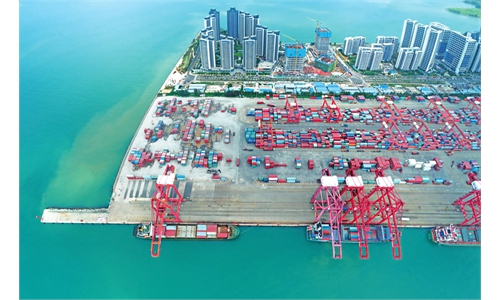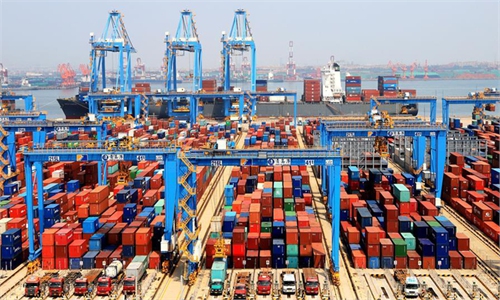ASEAN's economic miracle achieved through consensus & cooperation, not geopolitical rivalry: Ambassador to Cambodia
FTA, BRI open new chapter for China-Cambodia cooperation
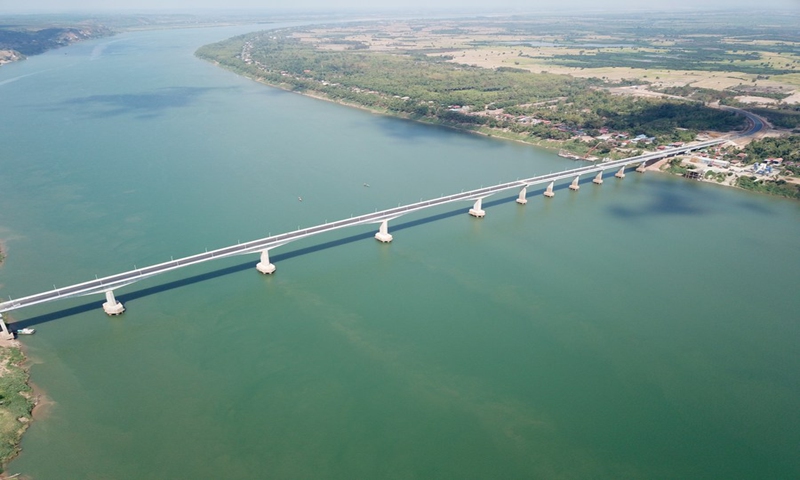
Aerial photo taken on March 11, 2021 shows the eighth Cambodia-China Friendship Bridge across the Mekong River, connecting Kampong Cham province and Tboung Khmum province in southeastern Cambodia. (Shanghai Construction Group/Handout via Xinhua)
Editor's Note:
While the world faces uncertainty amid COVID-19 outbreaks and geopolitical crisis, trade and economic cooperation between China and Cambodia has recorded strong growth momentum, achieving noteworthy results, including the Phnom Penh-Sihanoukville Expressway, the Sihanoukville Special Economic Zone as well as a vaccine filling plant.
In the first quarter of 2022, China-Cambodia trade volume reached $3.75 billion, up 39.2 percent year-on-year, with the growth rate ranking first among the Association of Southeast Asian Nations (ASEAN) members. China's non-financial direct investment in Cambodia reached $206 million, an increase of 35.2 percent; and Cambodia's investment in China reached $24.86 million, up 255 percent year-on-year.
The enhanced cooperation and the brethren spirit between the two countries have contributed to building the Cambodia-China community of a shared future and promoting the economic recovery of the wider region.
Global Times (GT) reporter Liu Yang recently conducted an exclusive interview with Wang Wentian (Wang), Chinese Ambassador to Cambodia, to discuss the achievements of the cooperation between China and Cambodia as well as ASEAN members under the China-Cambodia Free Trade Agreement (FTA) and the China-proposed Belt and Road Initiative (BRI). The ambassador also talked about the US-ASEAN special summit, noting that the economic miracle of the ASEAN has been achieved through consensus and cooperation, not geopolitical rivalry or violence.
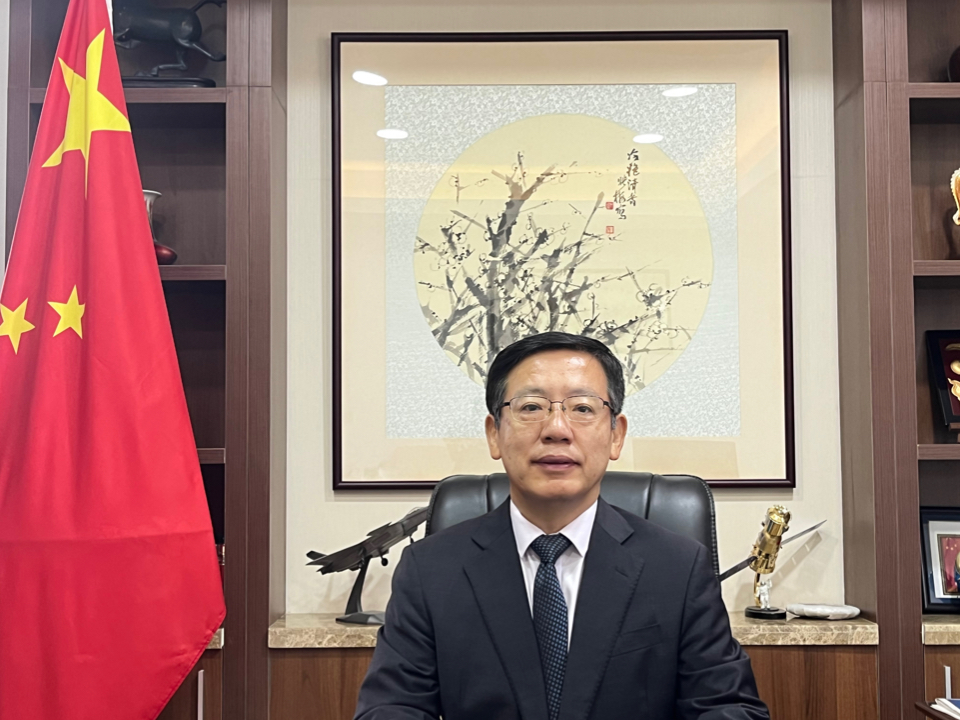
Wang Wentian, Chinese Ambassador to Cambodia Photo: embassy
GT: How do you evaluate the economic and trade cooperation between China and ASEAN in recent years? What are the results of the economic and trade cooperation between the two sides?
Wang: ASEAN has been a top trading partner of China. It took the second place from the US in 2019 and went straight to the top only the second year. With the Regional Comprehensive Economic Partnership (RCEP) and bilateral free trade arrangements such as the one between China and Cambodia coming into force, in the first four months of 2022, bilateral trade registered a growth of 9.4 percent to a staggering $290 billion, accounting for almost half of China' trade with RCEP members. The wind is in the sail. There is every reason for optimism.
And there is more to it than trade. Investment has been rising both ways, cross-border e-commerce thriving, our supply chains increasingly engaged, all of which point to the strong gravity that binds our peoples and markets closely together and keeps China-ASEAN cooperation on the fast track.
Building on that, China-ASEAN relations went one upper last November to Comprehensive Strategic Partnership (CSP) at the special summit commemorating the 30th anniversary of our dialogue relations, when President Xi Jinping espoused the "5 Homes Initiative" featuring peace, safety and security, prosperity, beauty and amity.
ASEAN members are not only our trade and investment partners. They are our neighbors, our brothers and sisters that claim high priority in our neighborhood diplomacy. Together, we are 11 countries and 2 billion strong. Together, we have turned this region into the most economically dynamic part of the world, a powerhouse for global growth and a bastion for peace and stability. Together, there is nothing we cannot achieve.
GT: How do you evaluate the cooperation between China and Cambodia in recent years?
Wang: At our Embassy compound there are two mango trees, gifts from H.M the late King Father and H.M the Queen mother in 1967. For decades now, they bear lavishly sweet mangoes every March to May, to the benefit of my colleagues and our Cambodian friends with whom we share.
That is a pertinent analogy to China-Cambodia relations, whose roots strike deep and fruits are bountiful. The exchanges of our peoples and cultures date back far beyond popular knowledge. As early as in the Yuan Dynasty (1279-1368), a Chinese diplomat named Zhou Daguan traveled to present day Siem Reap and wrote down A Record of Cambodia: the Land and its People, which holds the only surviving record of the Khmer Empire from the time.
On top of the strong historical bonds, our iron-clad friendship, as it is now often referred to, is anchored in our shared love for peace and stability, strengthened by our joint pursuit of fairness and justice, and aligned in our common approach to mutual respect and win-win cooperation in pursuing international relations.
In the same spirit, China-Cambodia cooperation has flourished. The secret formula is to grow with Cambodia, giving top priority to what our partner needs, instead of what outsiders want.
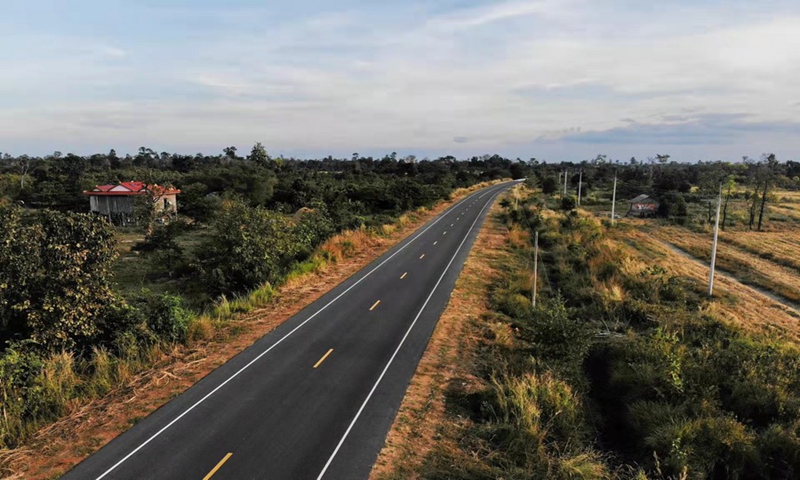
Aerial photo taken on Feb. 7, 2022 shows the China-funded stretch of National Road No. 7 in Kratie province, Cambodia. (Photo by Ly Lay/Xinhua)
GT: On January 1, China-Cambodia FTA came into force, which is the first FTA signed by China after the outbreak of the pandemic, and the first FTA to set up a separate chapter for cooperation under the BRI. How have the FTA and BRI integrated with Cambodia's Rectangular Strategy?
Wang: Cambodia has a Rectangular Strategy that highlight agricultural development, infrastructure, private sector development and job creation, as well as capacity building and human resources development. Those are the priority areas of our engagement to unleash the full potentials of our cooperation.
It is not simply sector by sector engagement, but a matrix of efforts that work better together. Take agriculture for example, we have introduced Cambodian mangoes, bananas, aquatic products into the Chinese market, and more is on the way. In 2021, Cambodia's rice export dropped 10.68 percent, but export to China rose by 7 percent, already accounting for nearly half of all Cambodian rice export.
These efforts get a strong boost from the China-Cambodia FTA, negotiated and signed in 2020 and came into force on January 1 this year. Infrastructure cooperation too is an important piece of the puzzle. Farm produce and industrial products need reliable power supply and roads and bridges and airports, again highlights of our cooperation. The Phnom Penh-Sihanoukville Expressway, first in Cambodia, is going to be operational soon. Myriads of power plants, bridges, hospitals, results of China-Cambodia cooperation frequently hit headlines of the local media, helping where they are needed the most. In the first four months of 2022, the Sihanoukville Special Economic Zone, a jointly invested industrial park creating tens of thousands of jobs for locals, saw its export grow by 50 percent year-on-year. In terms of capacity-building, the model combining study of Chinese language and professional skills is paving the way for even greater bilateral cooperation and higher-added value opportunities for the future. The list goes on, and the momentum in turn feeds back to bilateral relations.
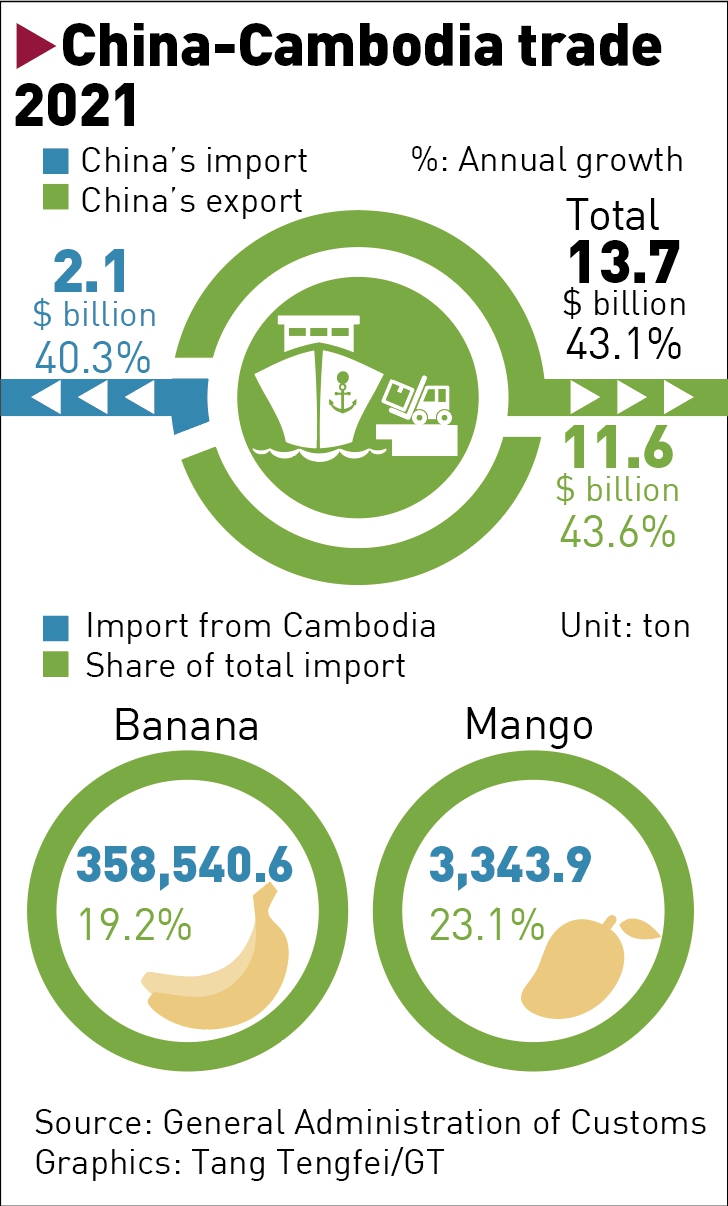
China-Cambodia trade 2021 Graphic: GT
In April 2019, both countries signed the action plan 2019-2023 on building the Cambodia-China community of a shared future, the first of its kind in the world. In addition to the progress and projects, this brethren spirit has delivered exemplary results in our fight against COVID-19.
When the pandemic first struck, Cambodian Prime Minister Hun Sen showed his staunch support to China and the Chinese people by visiting Beijing. Donations and assistance poured in from the Cambodia's Royal Family and all walks of life. In reciprocation, China sent medical teams, supplies to Cambodia and shared vaccines when they were needed the most.
To date, 42 million doses of Chinese COVID-19 vaccines have been delivered to Cambodia. The vaccines, the remarkable vaccination efforts by the Cambodian government and the cooperation from the public combined, have made Cambodia a most vaccinated country in the region and around the world. As we speak, Cambodia has not registered new COVID cases for days, while economic and social activities have fully returned to normal. And to consolidate the success, we will continue to deliver the vaccine donation announced by President Xi Jinping, and work with our Cambodian partners to help Cambodia set up a vaccine filling plant.
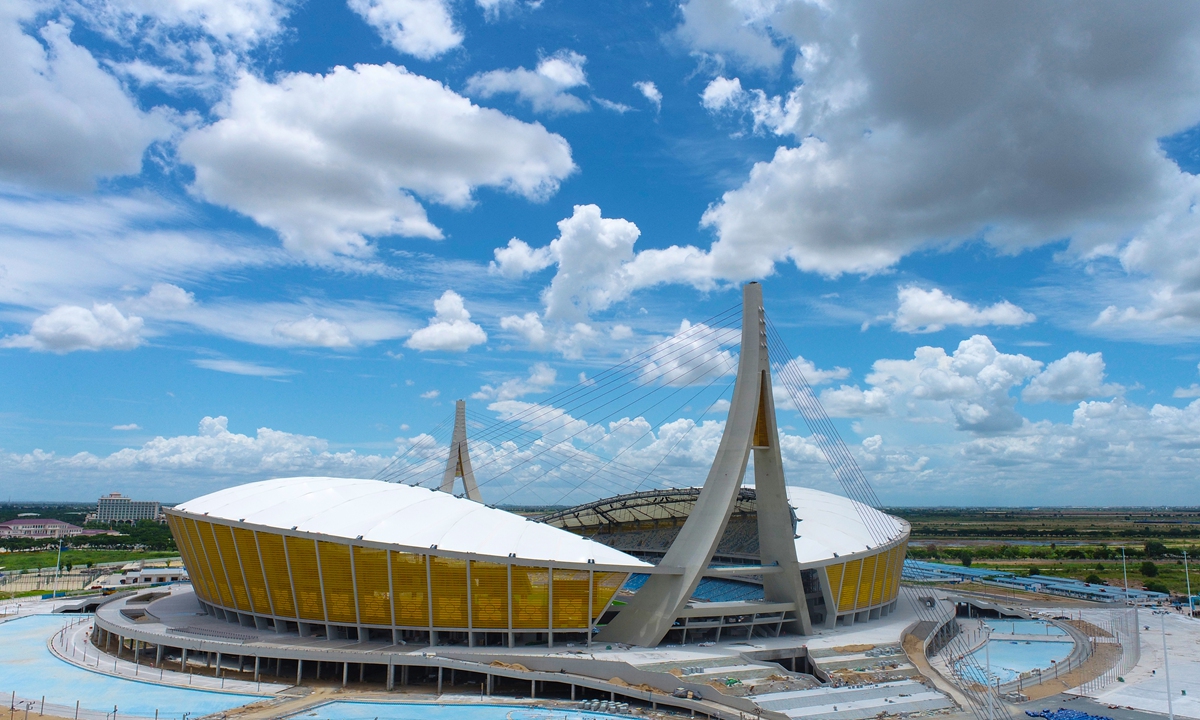
The China-funded Morodok Techo National Stadium officially opens in Phnom Penh, Cambodia, on December 18, 2021. Photo: Xinhua
GT: How do you evaluate the US-ASEAN special summit? Will there be competition between Build Back Better World (B3W) and China's BRI in the ASEAN?
Wang: Both China and the US are ASEAN's dialogue partners. Last November, President Xi Jinping hosted the special summit to commemorate the 30th anniversary of our dialogue relations, and upgraded China-ASEAN relation further to CSP. The US is coming the same way.
As a responsible stakeholder of the region, we welcome all constructive participation in regional cooperation by extra-regional countries, as long as they contribute to peace, stability, solidarity and prosperity.
The economic miracle of the region has been achieved through consensus and cooperation, not geopolitical rivalry or violence. If the success is to continue, it is imperative that everyone stays committed to the winning formula. We appreciate the expression of aversion to taking sides in the perceived rivalry by ASEAN leaders, including from Prime Minister Hun Sen, and will work with all like-minded countries in implementing the Global Development Initiative and Global Security Initiative to meet the global expectation for peace, cooperation and development.
At the end of the day, like is the case all over the world, what matters to ASEAN, its members and their peoples, is not what others ask from them, but what can be offered and delivered in tangible terms for win-win outcomes, and what we can all accomplish together, on the same side, as a team.
